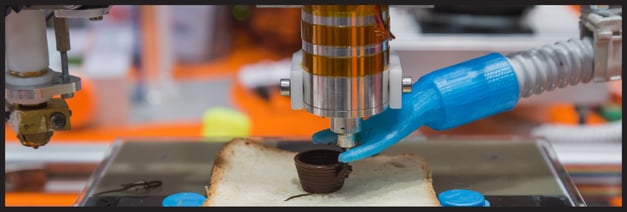
Does a 3-D printed pizza sound appetizing? Would a scanner that identifies the molecular structure of your food be helpful? How about a wand that promises to naturally eliminate sulfates from a glass of wine? Although many of these ideas sound like something out of a space-age movie, they are among some of the latest advances in food technology. Here, we take a look at a few of the most intriguing ideas in food.
Print-a-Pizza
Could a 3-D printed pizza spell the end of delivery? Not any time soon, but the concept of 3-D printed food was turning heads at the South by Southwest Eco Expo in March. The printer works by layering powdered ingredients onto a heated plate—15 minutes later, you have a ready-to-eat pizza. Although the product has yet to be approved by the FDA, the developer received a $125,000 grant from NASA to build the prototype with the intent to use it to provide food and a source of sustainable nutrients for astronauts on extended space travel. This isn’t the first attempt at crafting 3-D food; in 2011, a group at Cornell University developed a printer that could print chocolate, cheese, and turkey and earlier this year, Dutch scientists printed a hamburger. Could 3-D printers become as common in American kitchens as a toaster? That’s up to consumers to decide.
The New Molecular Gastronomy
Target’s little-known Co-Lab project is collaboration between MIT Media Lab and design firm Ideo. Bringing together more than 40 participants from different fields including scientists, statisticians, engineers, designers, and farmers, the partnership aims to address problems in our food system with high-tech solutions. The group intends to tackle the issue of transparency in food through the use of a spectrometer. The futuristic-sounding device works by shining infrared light into a food item to identify its molecular composition. With enough data, the machine has the ability to reveal a complete nutritional profile of the food, including calorie count, and nuances in taste. The researchers believe that the spectrometer could eventually replace food labels and give consumers more complete information about the food they are purchasing. But don’t expect the spectrometer to appear in your local grocery stores any time soon, one of the biggest challenges to its development includes gathering enough data to plot out the entire spectrum of food. Bottom line: consumers will have to keep reading labels.
Magic Wand
Along with a team of scientists, a father and son developed a spoon-like gadget that promises to remove histamines, sulfates, and preservatives from wine, allowing adults who are sensitive to those compounds the ability to indulge. According to the creators, when The Wand is immersed in the glass of wine, it absorbs up to 95% of histamines and preservatives. As an added plus, the developers The Wand’s movement through liquid aerates the wine and improves its flavor. The product is expected to roll out to consumers this year with initial sales coming directly through their ecommerce website.
Technology is innovating the way we live, and increasingly, the way we eat. Forward-thinking brands are already considering the possibilities and dreaming about new ways to surprise and delight consumers. Women’s Marketing understands the role that technology plays in a woman’s path to purchase—whether at the grocery store or at the beauty counter—and develops media strategies accordingly. Contact us to learn how we can help your brand develop a holistic media plan that incorporates cutting-edge technology and data-backed analytics.
Sources: Food Tech at SXSW, Fast Company Why Target is Fast-Tracking Innovation



Comments